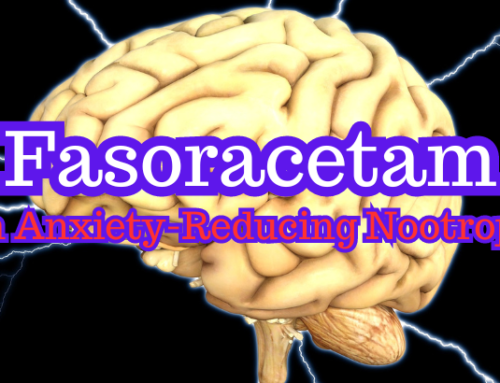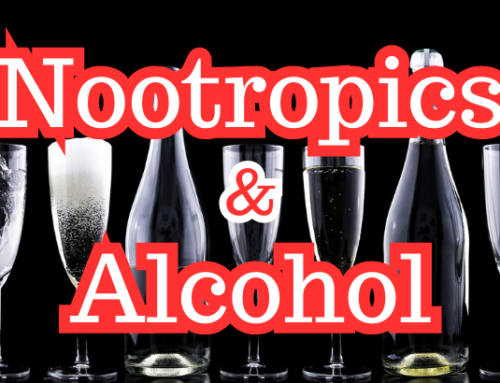When you think about nootropics, you probably think about using them to help you perform mental tasks: writing papers, studying for long periods of time, getting stuff done at work, etc. But did you know that they can also be used to improve physical performance?
Several nootropics have become popular for their ability to enhance various physical activities. Sports like tennis, golf, basketball, and many others require intense mental focus. Nootropics can help you to keep your mind sharp and your body ready for action.
If you're a regular Nootropics Zone reader, you already know that nootropics can improve mental performance in a variety of ways. But in this post, we're going to look at a few different nootropics that are being used to enhance physical performance.
Nootropics and Physical Performance
Caffeine and L-Theanine
The first nootropic on our list isn't a single nootropic – it's a simple and effective nootropic stack that is being used all over the world to improve both mental and physical performance. Caffeine and L-theanine go together like peanut butter and jelly. They work together to create a state of relaxed-but-focused energy.
Caffeine is the most widely used nootropic on the planet. Not only does it reliably improve mental performance: Caffeine also improves physical performance. Studies have shown that caffeine improves physical performance in just about every sport from basketball1 to running2.
Caffeine improves physical performance by increasing concentration and alertness, and by reducing fatigue.3 To put it simply, caffeine allows you to go harder and go longer. There's no question that it works. But caffeine works even better when combined with L-theanine.
 L-theanine has been shown to be able to improve mental alertness on its own.3 But when combined with caffeine, the two work together to drastically improve both mental and physical performance.4 L-theanine helps to reduce or even eliminate many of caffeine's negative effects: overstimulation, anxiety, insomnia, and the dreaded crash a few hours after using it. This creates a state of calm focus, allowing you to stay in the game longer without getting tired.
L-theanine has been shown to be able to improve mental alertness on its own.3 But when combined with caffeine, the two work together to drastically improve both mental and physical performance.4 L-theanine helps to reduce or even eliminate many of caffeine's negative effects: overstimulation, anxiety, insomnia, and the dreaded crash a few hours after using it. This creates a state of calm focus, allowing you to stay in the game longer without getting tired.
You can learn more about this simple-but-powerful nootropic stack here: L-Theanine and Caffeine – The Perfect Combo.
N-Acetyl-L-Tyrosine (NALT)
This is a more-soluble form of the amino acid L-tyrosine, which is a precursor to the neurotransmitter dopamine.5 The body quickly converts N-acetyl-L-tyrosine, or NALT for short, into L-tyrosine (or just tyrosine, for even shorter). Then it uses the L-tyrosine to make dopamine, a neurotransmitter known to play a role in focus, attention, motivation, mood, and anxiety.

Many sports require some serious multitasking. Take baseball, for example. Say you're the catcher and there's a runner on first base. You have to keep one eye on the pitcher and one eye on the runner. You have to interpret the pitcher's non-verbal signals to know what kind of pitch he's going to throw and you have to read the runner's body language to see if he's going to try to steal second. You need to pay attention to the wind. You need to pay attention to the batter. You need to pay attention to a lot of things – and all at once.
In baseball and most other sports, you need to be paying attention to a lot of things at once. You need to stay focused even when you're tired. That's where NALT seems to really shine. Supplementing with NALT can help you stay in the game longer, keeping your mind sharp and your body energized.
You can read more about NALT here: The Nootropic Benefits of N-Acetyl-L-Tyrosine (NALT).
Phenylpiracetam
This is a popular nootropic that is a member of the racetam family. It was created in a lab by modifying a piracetam molecule. Piracetam was the first nootropic to be discovered and even inspired the creation of the word nootropic. Phenylpiracetam is considered to be a mild stimulant and also has neuroprotective properties.9
 Users of phenylpiracetam find that it helps them to perform a variety of physical activities. But its use isn't limited to modern nootropic users. In Russia, phenylpiracetam is a prescription drug used to treat fatigue, prolonged stress, and other conditions. It was originally designed to help improve the performance of Russian cosmonauts. Aleksandr Serebrov, a cosmonaut who spent 197 days on the Russian space station Mir, said he used phenylpiracetam to reduce stress and irritability while in space.10
Users of phenylpiracetam find that it helps them to perform a variety of physical activities. But its use isn't limited to modern nootropic users. In Russia, phenylpiracetam is a prescription drug used to treat fatigue, prolonged stress, and other conditions. It was originally designed to help improve the performance of Russian cosmonauts. Aleksandr Serebrov, a cosmonaut who spent 197 days on the Russian space station Mir, said he used phenylpiracetam to reduce stress and irritability while in space.10
In the United States and most other countries, phenylpiracetam is available without a prescription. Nootropic users often report that it has a significant impact on physical and mental performance. Phenylpiracetam has been extensively studied in Russia, but the amount of research done in the U.S. And other English-speaking countries is limited. However, the studies that have been done support the claims that nootropic users have been making. Phenylpiracetam has been shown in studies to improve memory, reduce fatigue, increase motivation, and improve overall performance.11
You can learn more about phenylpiracetam here: Phenylpiracetam – The Best Adderall Alternative.
Kratom

For many people, kratom is a game changer. It doesn't work for everybody (nothing does), but when it does work it works wonders. Kratom is so effective that the World Anti-Doping Agency (WADA) put it on its Monitoring List in 2014.12 Countless people reported that it helps them to be active longer without getting tired and to stay focused when engaged in physical activity.
There is already a lot of evidence to support these claims and new studies are being published all the time. The studies that have been done on kratom show that it can be effective at relieving pain, it acts as a mild stimulant, and it can improve aspects of both mental and physical functioning.
You can learn more about this fascinating plant here: The Nootropic Benefits of Kratom.
Acetyl-L-Carnitine (ALCAR)

Studies show that ALCAR can boost athletic performance and increase maximum oxygen consumption in adults.14 They also show that it can reduce muscle soreness after intense physical activity.15 These findings are consistent with what many nootropic users have reported.
For me personally, ALCAR is by far the least effective nootropic on this list. But a lot of people really like it, saying it helps give them a little extra mental and physical energy throughout the day. Like with all nootropics, the only way to know what will work for you and what won't is to experiment on yourself a bit. And when you finally find something that works for you, you'll be glad you did.
To learn more about ALCAR, check out this post: Acetyl-L-Carnitine – A Nootropic Fat Burner.
Conclusion
Nootropics aren't only useful for improving cognitive performance. They can also great for boosting physical performance. The 5 nootropics (well, 6 technically) listed above can all help to keep you focused and alert, warding off fatigue and keeping you in the game longer.
We've taken a look at a few nootropics that can boost physical performance, but there are others. To learn about a variety of different nootropics, including some more that can boost physical performance, make sure to sign up for the Nootropics Zone newsletter below.
Have you used any of the nootropics mentioned in this post? If so, did you notice any improvement in physical performance? Or have you noticed any physical-performance-enhancing effects from any other nootropics not mentioned in this post? Please leave your answer in the comments section at the bottom.
To learn more about nootropics, sign up for the Nootropics Zone newsletter. You'll get the free gift, The Ultimate Nootropics Quick Reference Guide.
References
1Puente, C., Abian-Vicen, J., Salinero, J., Lara, B., Areces, F., & Del Coso, J. (2017). Caffeine improves basketball performance in experienced basketball players. Nutrients, 9(9):1033.
2Wiles, J., Bird, S., Hopkins, J., & Riley, M. (1992). Effect of caffeinated coffee on running speed, respiratory factors, blood lactate and perceived exertion during 1500-m treadmill running. British Journal of Sports Medicine, 26(2):116-120.
3Pesta, D., Angadi, S., Burtscher, M., & Roberts, C. (2013). The effects of caffeine, nicotine, ethanol, and tetrahydrocannabinol on exercise performance. Nutrition & Metabolism, 10:71.
3Nobre, A., Rao, A., & Owen, G. (2008). L-theanine, a natural constituent in tea, and its effects on mental state. Asia Pacific Journal of Clinical Nutrition, 17(Suppl 1):167-168.
4Camfield, D., Stough, C., Farrimond, J., & Scholey, A. (2014). Acute effects of tea constituents L-theanine, caffeine, and epigallocatechin gallate on cognitive function and mood: a systematic review and meta-analysis. Nutrition Reviews, 72(8):507-522.
5Magnusson, I., Ekman, L., Wangdahl, M., & Wahren, J. (1989). N-acetyl-L-tyrosine and N-acetyl-L-cysteine as tyrosine and cysteine precursors during intravenous infusion in humans. Metabolism, 38(10):957-961.
6Neri, D., Wiegmann, D., Stanny, R., Shappell, S., McCardie, A., & McKay, D. (1995). The effects of tyrosine on cognitive performance during extended wakefulness. Aviation, Space, and Environmental Medicine, 66(4):313-319.
7Thomas, J., Lockwood, P., Singh, A., & Deuster, P. (1999). Tyrosine improves working memory in a multitasking environment. Pharmacology, Biochemistry, and Behavior, 64(3):495-500.
8Deijen, J., & Orlebeke, J. (1994). Effect of tyrosine on cognitive function and blood pressure under stress. Brain Research Bulletin, 33(3):319-323.
9Malykh, A., & Sadaie, M. (2010). Piracetam and piracetam-like drugs: from basic science to novel clinical applications to CNS disorders. Drugs, 70(3):287-312.
10Федотова, О. (2004). Фенотропил: закономерное лидерство. Ремедиум, 36. Retrieved September 22, 2023 from https://medi.ru/info/427
11Zvejniece, L., Svalbe, B., Veinberg, G., Grinberga, S., Vorona, M., Kalvinsh, I., & Dambrova, M. (2011). Investigation into stereoselective pharmacological activity of Phenotropil. Basic & Clinical Pharmacology & Toxicology, 109:407-412.
12Guddat, S., Gorgens, C., Steinhart, V., Schanzer, W., Thevis, M. (2016). Mitragynine (kratom) – monitoring in sports drug testing. Drug Testing and Analysis, 8(11-12):1114-1118.
13L-Carnitine. (2019). Examine. Retrieved September 22, 2023 from https://examine.com/supplements/l-carnitine/
14Karlic, H., & Lohninger, A. (2004). Supplementation of L-carnitine in athletes: does it make sense? Nutrition,20(7-8):709-715.
15Giamberardino, M., Dragani, L., Valente, R., Di Lisa, F., Saggini, R., & Vecchiet, L. (1996). Effects of prolonged L-carnitine administration on delayed muscle pain and CK release after eccentric effort. International Journal of Sports Medicine, 17(5):320-324.
[This article was originally published on August 16, 2019. Updated September 22, 2023.]







Leave a Reply